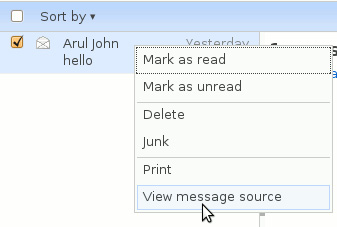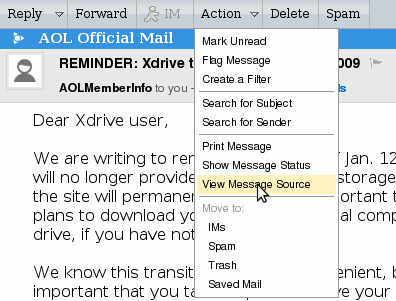Find IP address of sender accounts via Gmail, Yahoo, Hotmail, AOL, Outlook Express
Every time we receive an email, we don't just receive the content inside that message.Specifically, the Header section of the letter contains many important and necessary information about the origin of the sender, place of origin. In the following article, we will present some basic operations to help you identify this information in the simplest way.
But please be aware that this is only possible if the sender uses an anonymous proxy server system. Besides, if you receive an email sent from your Gmail account via a browser, it is difficult to find the correct IP address, because Google has a mechanism to hide this parameter when the data 'goes through'. server. However, if someone sends you an email from Gmail using a program, such as Thunderbird, Outlook, Apple . then this process will become much simpler.
With Gmail:
First, you log into your Gmail account with Username and Password as usual, open any email. To display the Header section of that email, we click the button with the triangle icon next to the Reply to All link and select Show Original:

Look in the Received section, the information here will look like this:
Received: from [69,138.30.1] by web31804.mail.mud.yahoo.com
The number line inside brackets [] is the IP address you want to find, but if you get a lot of Received values included, choose the last value.
With Yahoo:
Same as above, after you log in to your account, select the Inbox and Subject of the email you need to test, right-click and the system will display the menu as shown below:

Continue, find information in Received: from section similar to Gmail. If there are multiple Received: from lines, use the data in the last line. If you can't find any Received: from line, look for X-Originating-IP instead.
With Hotmail:
As we all know, Hotmail has officially been integrated with Windows Live, so the general format has changed a bit. And the following are the steps to proceed.
Log in to your Hotmail or Windows Live account , select the Inbox link on the left. Below the column with the Sort by title, select any email and right-click, you'll see a menu showing some elements like Mark as read, Mark as unread . and finally View message source

Then we will see the Header section of the email. Similarly, look for the information starting with X-Originating-IP - this is the sender's IP address. If there is no X-Originating-IP then we will continue to receive Received: from and the accompanying number is enclosed in brackets []. In case you have multiple Received: from lines, it is necessary to remove the component that comes with the parameter like proxy.anyknownserver.com .
With AOL:
The way to do it with AOL is not much different from the above. To get started, log in to your account with Username and Password, select the email you want to test, above you choose Action> View Message Source from the menu that displays:

The program will open a new page with the attached Header tab, here we just need to search for the information that comes with the X-AOL-IP parameter .
Good luck!
You should read it
- Import email from Gmail to Google App using Outlook, Thunderbird
- Send and receive Gmail messages with Outlook
- Instructions for using Gmail shortcuts in Outlook web apps
- Email address say about you?
- Use Outlook Express to send / receive Yahoo mail
- All you need to know about Outlook Express on Windows 10
- How to Forward Emails from Yahoo to Gmail
- How to register, create a HotMail account, Outlook Express 2019
May be interested
- Send and receive Gmail messages with Outlook
 with increasing capacity and built-in utilities, gmail has become the # 1 webmail in the world. this article will show you how to set up the parameters so that you can access gmail in a offline way by using mail browsing software such as outlook express, windows mail, ...
with increasing capacity and built-in utilities, gmail has become the # 1 webmail in the world. this article will show you how to set up the parameters so that you can access gmail in a offline way by using mail browsing software such as outlook express, windows mail, ... - Use Outlook Express to send / receive Yahoo mail
 many people have been using yahoo mail as a primary email for sending mail. however, being constantly logged into yahoo mail to check mail is annoying and does not guarantee regularity. there is a way to send / receive mail with yahoo mail through the outlook express email client support program.
many people have been using yahoo mail as a primary email for sending mail. however, being constantly logged into yahoo mail to check mail is annoying and does not guarantee regularity. there is a way to send / receive mail with yahoo mail through the outlook express email client support program. - Compare Gmail and Outlook.com
 gmail and outlook.com are two of the most popular web mail services, and each has its own benefits. most people use both email providers or use either of them as primary or secondary accounts.
gmail and outlook.com are two of the most popular web mail services, and each has its own benefits. most people use both email providers or use either of them as primary or secondary accounts. - How to create a signature in a Hotmail mailbox
 like gmail or yahoo mail, users can create signatures in hotmail to introduce themselves, or those who use hotmail in their work will show their professionalism with their partners.
like gmail or yahoo mail, users can create signatures in hotmail to introduce themselves, or those who use hotmail in their work will show their professionalism with their partners. - Instructions for adding Gmail accounts to Outlook 2013 and 2016 using IMAP
 if you use outlook to check and manage email, you can also do this with gmail. you can set up your gmail account to allow email synchronization on multiple computers using email client instead of on a browser.
if you use outlook to check and manage email, you can also do this with gmail. you can set up your gmail account to allow email synchronization on multiple computers using email client instead of on a browser. - How to Set Up Email Filters in Gmail, Yahoo Mail, and Outlook
 gmail, yahoo, and outlook offer powerful filtering tools that give you control over everything.
gmail, yahoo, and outlook offer powerful filtering tools that give you control over everything. - 4 tips to prevent fake attacks
 in this article, i will show you some ways to fix fake attacks on recent gmail, hotmail and yahoo email services:
in this article, i will show you some ways to fix fake attacks on recent gmail, hotmail and yahoo email services: - Instructions for using Gmail shortcuts in Outlook web apps
 anyone who uses keyboard shortcuts knows that web mail applications often provide their own keyboard shortcuts, in which microsoft oulook differs from google mail, unlike yahoo! mail, ... however, with outlook.com, you can change the default shortcuts for the outlook web application to google's gmail shortcut or the yahoo mail app. this will definitely be convenient for people who use multiple web applications every day without having to study new shortcuts.
anyone who uses keyboard shortcuts knows that web mail applications often provide their own keyboard shortcuts, in which microsoft oulook differs from google mail, unlike yahoo! mail, ... however, with outlook.com, you can change the default shortcuts for the outlook web application to google's gmail shortcut or the yahoo mail app. this will definitely be convenient for people who use multiple web applications every day without having to study new shortcuts. - Transfer contacts from Gmail, Hotmail, Facebook to Yahoo! Mail
 the most worrisome thing when switching to other webmail is that it cannot bring the list of contact email from the old mailbox ...
the most worrisome thing when switching to other webmail is that it cannot bring the list of contact email from the old mailbox ... - How to Create Multiple Email Accounts
 this is an article on how to create multiple email accounts using gmail, outlook and yahoo. you can create and link multiple email accounts, and switch between them easily, or create other names so you can add multiple email addresses to one account. using a different name is useful when you are asked to provide an email address on an untrusted website or when you want to sign up for a special offer without receiving spam.
this is an article on how to create multiple email accounts using gmail, outlook and yahoo. you can create and link multiple email accounts, and switch between them easily, or create other names so you can add multiple email addresses to one account. using a different name is useful when you are asked to provide an email address on an untrusted website or when you want to sign up for a special offer without receiving spam.










 Vietnam Hacker forum was paralyzed
Vietnam Hacker forum was paralyzed Some free 'hack' tools
Some free 'hack' tools The conclusion for hackers stole 114,000 iPad accounts
The conclusion for hackers stole 114,000 iPad accounts The most famous horny names in history
The most famous horny names in history 10 hackers are welcomed by technology firms
10 hackers are welcomed by technology firms Anonymous threatened to knock down the New York Stock Exchange
Anonymous threatened to knock down the New York Stock Exchange